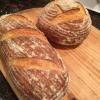
July 14, 2007 - Caraway Rye Quick Bread
After seeing so many lovely rye loaves here, I wanted one for dinner. Since I didn't have time (or enough yeast) for a yeast bread, I decided to try and find a quick bread recipe online. This was a bit sweet for my taste, but I might make it again with less honey. With the sweetness, I quite enjoyed it for breakfast the next morning. I'm also going to order the deli rye flavor enhancer from King Arthur for future loaves - whether yeasted or quick.

CARAWAY RYE QUICK BREAD
2 teaspoons caraway seeds
1/2 cup all-purpose flour (I used all WW pastry flour ~kip)
1/2 cup whole wheat pastry flour (or use all-purpose flour)
1 cup rye flour
2 teaspoons baking powder
1/2 teaspoon baking soda
1/2 teaspoon salt
1/4 cup melted butter
2 eggs
1/4 cup honey
3/4 cup buttermilk (plus 2 tablespoons to account for extra WW flour ~kip)
Preheat oven to 350 degrees. Grease an 8-inch round cake pan.
Toast the caraway seeds in a small dry skillet over medium-high heat for 2 or 3 minutes, or until fragrant. Transfer to a small plate to cool; set aside. (I ground these in a spice grinder before adding to the flour mix. ~kip)
Combine the flours with the baking powder, baking soda, toasted caraway seeds and salt in a medium mixing bowl.
In a separate bowl, whisk together the melted butter, eggs, honey and buttermilk. Stir liquid ingredients into flour mixture until just blended. Do not overmix; the batter will be lumpy. Pour into prepared pan.
Bake 40-45 minutes until top springs back when touched lightly. Cool slightly in the pan, cut into wedges and serve warm, if desired.
This bread is especially good warm. To reheat later, wrap a wedge loosely in a paper towel and microwave on half heat for 20-30 seconds.
http://www.apinchof.com/caraway1035.html







